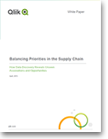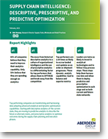Lemonade and the Supply Chain
How can supply chain management be so easy and yet so difficult? Increasing complexity and competition in markets that already operate on low margins make success in the supply chain more important than ever.
I really like this Supply Chain video from MIT (view above).
It features a couple of kids who make a success of their lemonade stand by following some basic supply chain management principles.
They end up stealing a march on their competition and winning the day. It’s a fun way of showing what can be a very dry topic and is designed to show that at the end of the day, it’s “kid’s stuff.”
Of course, basic principles are one thing; managing increasingly global supply chains can be another matter entirely.
There is inherent complexity in today’s supply chains with multiple systems often being used to manage interconnected processes.
This can make getting a clear view of the end-to-end process quite challenging.
It can be said that supply chain management is fundamentally about balancing priorities which can often compete.
For example, how do you reconcile product availability with managing inventory levels, and production efficiency with maintaining quality?
Supply chain practitioners will talk about volatility being one of the major issues; ultimately businesses need to make sure their products are available for customers to purchase.
This means identifying and reducing risk in the supply chain and building resilience in the network.
An effective and efficient supply chain will always be a real differentiator for a company, and many studies have shown the correlation between supply chain performance and financial results. Data and the ability to collaborate around it will always be central to a successful supply chain. The sources and complexity of data continue to grow exponentially, making the management of the KPI’s which underpin supply chain performance even more challenging.
The kids in the video learned about the need to forecast, manage inventory, optimize transportation and develop a vendor strategy. These are all valid supply chain disciplines, but also easy to over simplify. The challenge is in the diversity and volume of activities and the need to manage business performance across, as opposed to within functional silos.
Add to this the need to build effective sustainability and regulatory compliance across the supply chain, as well as managing the very real issues around product obsolescence that are faced in many industries, and you are suddenly faced with a potentially complex set of challenges.
“The Chief Supply Office Report” from SCM World stated that respondents increasingly “need people who can handle the technical duties of supply chain across silos, who can apply business judgement continually in action and with any luck, who are able to master emerging tools for data collection and analysis”.
It would seem that it’s not quite as easy as the kids running the lemonade stand would lead us to believe. It is however fair to say that the principles that they uncovered are simple which I think is a reasonable compromise. What contributes to this juxtaposition is the complexity of the environment that supply chain professionals work in.
These are arguably the broadest set of data sources supporting business processes that straddle many functions. In my experience, possibly the greatest challenge is how trading partners can be encouraged to collaborate in a meaningful way when ultimately they are competing for a greater share of the value chain.
This can and does happen when all parties can see that there is value in collaborating and the tools and processes are in place to make it transparent and achievable.
Increasing complexity and competition in markets that already operate on low margins; coupled with a never-ending requirement for innovation, efficiency and compliance make success in the supply chain more important than ever.
The tools that we now have at our disposal make the lemonade stand panacea closer than you might think.
David Telford
Senior Director, Sector Group & Industry Partner Lead at Qlik
Download Qlik Visual Analytics Resources
Balancing Priorities in the Supply Chain
This paper demonstrates how Data Discovery software helps generate insight and provides decision-makers with increased visibility to help identify risks and opportunities.
The Sustainable Supply Chain
A key priority for developing a sustainable supply chain is the ability to collect and analyze insights from data, however, deriving and sharing these across stakeholders can be impeded by the huge volume and complexity of the data.
Aberdeen Group’s Supply Chain Intelligence: Descriptive, Prescriptive, And Predictive Optimization
The goal of any analytics solution is to provide the organization with actionable insights for smarter decisions and better business outcomes, however, different types of analytics provide different types of insights.
















